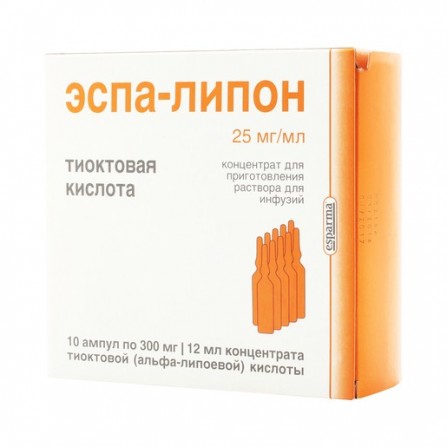Espa-Lipon concentrate for solution for infusion ampoules 12 ml 10 pcs
Condition: New product
1000 Items
Rating:
Be the first to write a review!

More info
Active ingredients
Thioctic acid
Release form
Solution
Composition
1 vial contains: ethylene diamine salt of thioctic acid 387.6 mg, which corresponds to the content of thioctic (α-lipoic) acid 300 mg Auxiliary substances: water d / and.
Pharmacological effect
Metabolic drug. Thioctic (α-lipoic) acid is found in the human body, where it acts as a coenzyme in the reactions of oxidative phosphorylation of pyruvic acid and alpha-keto acids. Thioctic acid is an endogenous antioxidant, according to the biochemical mechanism of action, it is close to the vitamins of group B. Thioctic acid contributes to the protection of cells from the toxic effects of free radicals that occur in metabolic processes; it also neutralizes exogenous toxic compounds that have entered the body. Thioctic acid increases the concentration of the endogenous antioxidant glutathione, which leads to a decrease in the severity of symptoms of polyneuropathy. The drug has a hepatoprotective, hypolipidemic, hypocholesterolemic, hypoglycemic effect; improves trophism of neurons. The result of the synergistic effect of thioctic acid and insulin is an increase in glucose utilization.
Pharmacokinetics
The distribution and metabolism of Vd is about 450 ml / kg. The main metabolic pathways are oxidation and conjugation. Excretion of thioctic acid and its metabolites are excreted by the kidneys (80-90%). T1 / 2 - 20-50 minutes. Total plasma clearance - 10-15 ml / min.
Indications
Diabetic polyneuropathy; alcoholic neuropathy.
Contraindications
Hypersensitivity to the components of the drug Espa-Lipon; Children's age (efficacy and safety have not been established); Pregnancy, breastfeeding period (there is not enough experience with the drug).
Precautionary measures
Alcohol consumption is a risk factor for the development of polyneuropathy and may reduce the effectiveness of Thioctacid, so patients should refrain from taking alcoholic beverages both during treatment with the drug and during periods outside of treatment.
Use during pregnancy and lactation
The drug is contraindicated during pregnancy and lactation, because there is insufficient experience with the drug during these periods.
Dosage and administration
The drug is designed to prepare a solution for infusion after preliminary dilution in isotonic sodium chloride solution. Severe forms of diabetic or alcoholic neuropathy Once a day in the form of intravenous drip infusions 24 ml of solution in 250 ml of isotonic sodium chloride solution (which corresponds to 600 mg of alpha lipoic acid per day). The drug is recommended to be used within 2-4 weeks. Solutions for infusion should be administered within 50 minutes. Prepared solutions must be stored in a dark place and used for a maximum of 6 hours after preparation. Next, you should switch to maintenance therapy in the form of pills at a dose of 400-600 mg per day. The minimum duration of treatment with pills is 3 months.
Side effects
Allergic reactions are possible: urticaria, systemic allergic reactions (up to the development of anaphylactic shock). Perhaps the development of hypoglycemia (due to improved glucose uptake). If ingestion is possible dyspeptic symptoms, including nausea, heartburn, vomiting. When administered intravenously, seizures are very rare; diplopia; point hemorrhages in mucous membranes, skin; thrombocytopathy; hemorrhagic rash (purpura), thrombophlebitis. With the rapid introduction may increase intracranial pressure (the appearance of a feeling of heaviness in the head); difficulty breathing.
Overdose
No cases of overdose with the preparation of thioctic acid in the form of a solution for intravenous injection have been noted. Treatment (in case of overdose): symptomatic, if necessary - anticonvulsant therapy, measures to maintain the functions of vital organs.
Interaction with other drugs
With simultaneous administration of thioctic acid and cisplatin, cisplatin decreases in effectiveness. With simultaneous use of thioctic acid and insulin or oral hypoglycemic drugs, their effect may increase, therefore regular monitoring of blood glucose levels is recommended, especially at the start of thioctic acid therapy. In some cases, it is permissible to reduce the dose of hypoglycemic drugs in order to avoid the development of symptoms of hypoglycemia. Ethanol and its metabolites weaken the action of thioctic acid. Pharmaceutical interaction The infusion solution of thioctic acid is incompatible with dextrose solution, Ringer's solution and with solutions that react with disulfide and S-groups, ethanol.
special instructions
Treatment of diabetic polyneuropathy should be carried out against the background of maintaining the optimal concentration of glucose in the blood.




